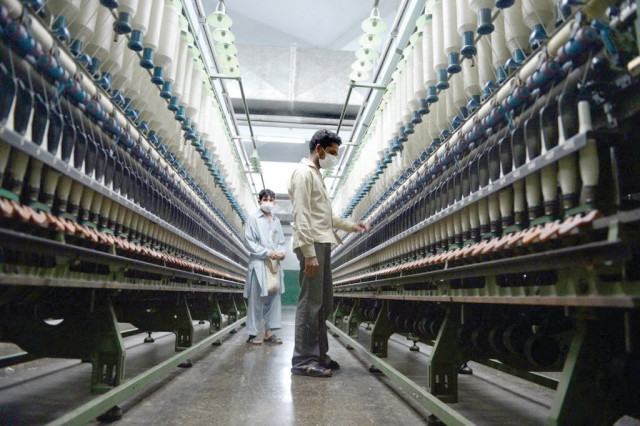Potential of boosting Pakistan’s exports
Islamabad needs to establish ‘commercial consulate’ in Beijing to facilitate exporters

There are vast benefits of trade with China. Currently, China ranks as the second-largest market for Pakistani products with a 7% share, while the US has a share of 16.7% in total exports. China is also the second-largest source of the country’s imports.
Owing to the free trade agreement (FTA), there has been a surge in exports to China. The trade growth has increased by up to 26% because of the free trade policy from 19%.
The Chinese government has shown great interest in expanding trade with Pakistan. It is hoping to import more goods from Pakistan. Vegetables and fruits are expected to be imported by China.
Pakistan imports machinery but the industrial infrastructure requires a lot of development to make cost-effective production possible.
In China, there is a huge demand for Pakistani mangoes, berries, potatoes, wheat, rice and citrus fruit. The two countries are also working on developing genetically engineered rice. Another big project is to build reliable supply chains for halal food.
Windows of opportunities
In China, there are specific opportunities for Pakistan in the agriculture sector as the country is facing problems with the quality of its irrigated land area. There is a growing shortage of it. For some crops, it is severe.
China prefers trade for its agrarian needs with Asian countries, such as Pakistan, India, Thailand and Vietnam.
Rice trade between Thailand and China is difficult due to high tariffs. It was a success for Pakistan that grabbed the opportunity and filled the market gap. Pakistan, after being the top exporter of cotton to China, became the second largest exporter of rice to Beijing.
Pakistan’s Adviser on Commerce and Trade Abdul Razak Dawood sees the possibility of expansion. Introducing new products is essential but expanding the current product export volumes is equally important.
Sugar comes as a priority for Dawood. He notes that trade of several future items will rise, which will further solidify the Pak-China geopolitical relationship.
There is another important area which covers minerals and precious stones. Under the China-Pakistan Economic Corridor (CPEC) project, tariffs have been reduced from 35% to 0%. Now, gold and copper reservoirs have also become a focus of Chinese engineers as they have been discovered in Reko Diq.
China has expressed the possibility of importing CPEC-made products in the agricultural and horticultural sectors, because of quarantine problems in the potential importing nations.
Barriers and advantages
Dawood expressed the view that Pakistan would be trying its best to increase trade with China. There are specific problems which come in the way of realising that.
Most of the Pakistani exports go to Europe and the US, but China is Pakistan’s biggest exporting destination. It is mostly raw material which Pakistan exports to China. Cotton and hard chromium account for 66% of exports. This has not changed for quite a long time.
There is a significant advantage that Pakistan has, unlike other nations trading with China, which is the FTA. It offers the potential of growth for many Pakistani products.
The FTA with China should give Pakistan an edge over other countries in several potentially high profit-generating products such as textiles and sports. But the country has been unable to take advantage of this substantial market because of non-tariff barriers.
In most of these goods that have a huge potential, Pakistani exporters have failed to make headway because of the non-tariff barriers.
The barriers noted by the World Trade Organisation (WTO) are time-consuming and high-cost bureaucratic procedures, lack of commercial judiciary, lack of transparency and non-standardised tenders.
Furthermore, there is a communication gap between the two countries, unlike Pakistan’s other trade partners. This creates hesitation among traders of both countries because they are unable to understand each other’s expectations and lack trust because of the absence of a bridging factor.
Once a deal is dropped, or a bad experience happens, it becomes difficult for the party at a loss to regain trust.
China is a big market, and sometimes it is seen that there is not enough supply on the side of Pakistan. China demands imports because it has shortage in the labour market. The high cost makes it difficult to compete with foreign competitors.
There is an issue of marketing. Pakistan needs to highlight the trade opportunities in the CPEC project because many traders from both countries do not know sufficiently about it. Due to this drawback, several opportunities remain out of the scope of local and foreign-resident traders.
Several reports indicate the discomfort of Pakistani traders with the intensive investigation of their products, which sometimes spoil the goods. This is because a Pakistani product is not highly esteemed in China.
Suggestions
Pakistan is in a huge need to shift from exporting raw material and simple manufactured goods to higher value-added products. In this way, the labour market will benefit and growth will continue to expand.
It is advised that Pakistan needs to build a “commercial consulate”, separate from the embassy in China. This will facilitate exporters to understand the Chinese demand based on research of institutes, and will connect Chinese traders with Pakistani counterparts.
It is also suggested that the Trade Development Authority of Pakistan should allocate a budget for improving the branding and marketing of Pakistani goods.
It is hoped that the government will help traders in building efficient procurement and distribution networks so that the quality of goods can be improved in the Chinese customer’s perception.
The article originally appeared on the China Economic Net
Published in The Express Tribune, July 20th, 2020.
Like Business on Facebook, follow @TribuneBiz on Twitter to stay informed and join in the conversation.



















COMMENTS
Comments are moderated and generally will be posted if they are on-topic and not abusive.
For more information, please see our Comments FAQ